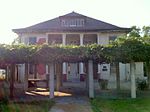Workman and Temple Family Homestead Museum
1981 establishments in CaliforniaBuildings and structures on the National Register of Historic Places in Los Angeles County, CaliforniaCalifornia Historical LandmarksCity of Industry, CaliforniaHistoric American Buildings Survey in California ... and 11 more
Historic house museums in CaliforniaHistory museums in CaliforniaHouses completed in 1842Houses in Los Angeles County, CaliforniaHouses on the National Register of Historic Places in CaliforniaMuseums established in 1981Museums in Los Angeles County, CaliforniaOpen-air museums in CaliforniaSan Gabriel ValleySpanish Colonial Revival architectureSpanish Revival architecture

The Workman and Temple Family Homestead Museum is a historic house museum located at 15415 East Don Julian Road in City of Industry, California, that features the homes and private cemetery that belonged to the pioneer Workman-Temple family.
Excerpt from the Wikipedia article Workman and Temple Family Homestead Museum (License: CC BY-SA 3.0, Authors, Images).Workman and Temple Family Homestead Museum
El Encanto Road, El Monte City of Industry
Geographical coordinates (GPS) Address Nearby Places Show on map
Geographical coordinates (GPS)
| Latitude | Longitude |
|---|---|
| N 34.02 ° | E -117.96416666667 ° |
Address
El Encanto Road
91745 El Monte, City of Industry
California, United States
Open on Google Maps







